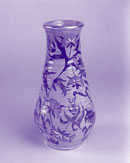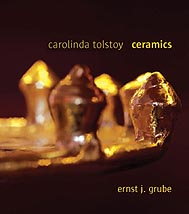




 |
    |
Reviews |
||
 |
Middle East
Carolinda Tolstoy Ceramics A review by Juliet Highet For anyone interested in contemporary ceramics or Islamic pottery, this is the book of not just the moment, but of the decade. Of course you can just flick through, admiring the stylish design and stunning photography of ornate, gilded ceramics, the dramatic close-ups of Eastern silks and ornate jewellery, the embellished hands of a latter-day Odalisque, which nevertheless are throwing pottery. On first impression an exotic, Oriental world leaps off the pages. Now, plunge in, read on... The author of Carolinda Tolstoy Ceramics is Ernst J. Grube, a leading world authority on Islamic art, President of the East West Foundation, NY and Professor Emeritus, University of Venice. He was instrumental in establishing the Department of Islamic Art, Metropolitan Museum NY and became the first Curator. In the gloriously pink and gold inside front cover of the book, he contends that "Countess Carolinda Tolstoy is undoubtedly the major contemporary representative of a considerable 'Orientalist' tradition. Her work has justly been recognised as perpetuating the fascination of the Western world with Safavid art, with an indebtedness to a truly original interpretation of the Ottoman tradition." Tolstoy herself says, "My influences have been Hispano Moresque, Turkish Iznik and more recently Persian Safavid Esphahan." She adds, "I love the spontaneous aspect of hand-thrown pottery. While working with clay, I am constantly aware of it having a life of its own, which I try to retain by not over-finishing. I like the contrast between simple shapes and rich decoration, for which I employ a faïence technique with lustre." Working on red earthenware with tin glazes, her pottery shimmers ethereally in its lustre; and over its delicate pastel grounds, the swirling surface decoration glows in gold. As Dr. Sheila Canby, of the British Museum's Department of Oriental Antiquities, points out, "Tolstoy's work demonstrates the internationalism of great art and its ability to 'speak' to people of various cultures and periods without a great deal of verbal explanation. Not only does her choice of imagery relate to Safavid painting, but also her technique is in the tradition of fine Persian pottery, and even the revival of lusterware, which took place in Iran in the 17th century. While Tolstoy's Persian-inspired ceramics must certainly appeal to those familiar with Safavid art, they also are intriguing examples of the twentieth century potter's art. I applaud her skill in uniting traditional Persian imagery and modern ceramic forms and techniques." In his Introduction to Carolinda Tolstoy Ceramics , Grube places Tolstoy's work in history, illustrating her inspirations, and tracing the traditions of Middle Eastern pottery, as well as her relationship to twentieth century ceramics. He demonstrates how rather than draw on far Eastern sources, as so many of her contemporaries have done, Tolstoy has continued and expanded the Islamic ceramic heritage in a unique way. Other modern luminaries in the field such as Alan Caiger-Smith and Sutton Taylor, have adapted the lustre of Persian pottery, without adopting the designs, preferring abstraction. Tolstoy's floral, rock and wave, and arabesque scrolls relate closely to Ottoman Iznik pottery, her figurative designs to Persian Safavid miniatures. She also borrows decorative elements and concepts from several forms of Islamic applied arts, such as metalwork and textiles. |

|
| © Carolinda Tolstoy 1999-2018 | Web site design: QuincDigital |